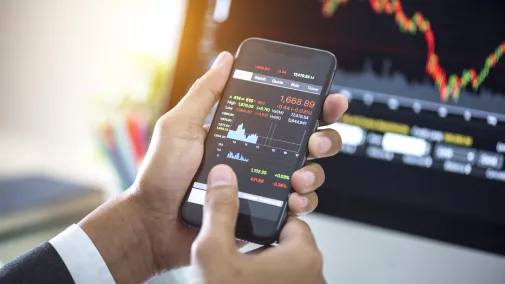
The digital euro – what makes it so special?
published on 08.10.2020
Facebook wants it, China almost has it – a programmable digital currency. Europe too is talking about the ‘digital euro’. But what exactly is that? Which types of money exist and how do they differ? We have the facts.
Money or currency?
Programmable and non-programmable (digital) money, CBDC, crypto values, digital or e‑euro, digital central bank money – when talking about digital currency, the range of different terms used is vast. In order to understand these discussions, we need to explain these terms.
The first thing that needs to be clarified is the difference between money and currency:
Money
Money is a generally accepted means of exchange and payment. It describes a de facto standard, even if it is not legal and official tender: That’s why money is not only the official coins and notes, but also the notes of a regional currency or any other medium of exchange that is used.
Currency
A currency is legal tender, i.e. a de jure standard. The euro, for instance, is a currency; a digital euro issued by the European Central Bank (ECB) would be a digital version of this currency. In other words, a currency describes the legal framework that defines the monetary system of an economic area.
The most significant difference between money and currency is value. While money has a fixed value that remains constant over time, a currency is merely the representation of a value that can change over time due to exchange rate fluctuations, thus making it volatile.
What are the different forms of money?
How the monetary system in Germany works: The private scriptural money regime of the banks is supported by the central bank and de facto guaranteed by the state. But what do these terms actually mean?
Cash
Banknotes and coins are cash which is issued by the central bank. However, it is spent by private companies, for instance, through account withdrawals or as change when purchases are made in shops. According to the law, "banknotes denominated in euro" are the only unlimited legal tender in this country. Cash accounts for only about 10 percent of the total supply of euro money. It is a generally accessible means of payment. Cash is important for people because they can use it as an anonymous form of payment for goods and services. For the monetary system, however, it is of marginal importance only and no longer determines the system. Cash is produced by Bundesdruckerei, among others.
Book or scriptural money
Book or scriptural money accounts for 80 percent of euro money supply. It is generated by the banks – i.e. in the private sector – by granting loans to create money. This demand deposit is electronic money and not ‘unlimited legal tender’. Cash can be deposited into the bank account and thus becomes scriptural money. Scriptural money can be exchanged for cash at any time. Anyone with scriptural money, i.e. a bank account with a credit balance, can transfer this to other accounts and thus pay bills. Direct debit, cheque or card payments are also made using electronic scriptural money.
Central bank money
Central bank money also accounts for around 10 percent of euro money supply. This is money issued by a central bank – i.e. by the state – which can be both cash and book money. Only banks and selected financial institutions have access to central bank money in Germany.
A central bank, in some countries also referred to as a national bank, is a public institution that is responsible for a country’s currency and controls the supply of money, i.e. the amount of money in circulation. A central bank is not a commercial bank; it is not possible to open an account or apply for credit at a central bank. Although central banks do not operate on a profit basis, they can generate a profit. Commercial banks can borrow money from the central bank. Central banks are responsible for monetary policy and have a wide range of other tasks: They issue banknotes and coins, ensure that the payment system works and manage foreign exchange reserves.
Crypto values,such as Bitcoin or Ethereum, are created by private entities and must assert themselves on the market. To achieve this, they must generate benefits and win the trust of their users. Most crypto values are based on so-called Distributed Ledger Technology (DLT), such as blockchain technology. Unlike conventional electronic money, crypto money can be linked to so-called smart contracts. Put simply, smart contracts are used to make automated payments. In other words, crypto money is a kind of ‘programmable digital money’. Due to the strong fluctuations in value and high transaction fees of crypto money, many companies do not accept crypto values as a means of payment.
What does digital money mean?
Digital money is money in electronic form. In the future, we will have to distinguish between programmable and non-programmable digital money. Both terms are often used synonymously, but there is one significant difference:
Non-programmable digital money
Non-programmable digital money is already available today – both account-based money (scriptural money in non-cash payment transactions) and cryptography-based money, e.g. Bitcoin. This digital euro can be used to manage amounts in euro only – just like a bank account with a money transfer function.
Programmable digital money
Looking to the future, we are set to see programmable digital money that can be both account-based and crypto-based. Libra is crypto-based, digital programmable money. In today's business transactions, the delivery process and the payment process are handled separately. However, the blockchain-based programmable euro makes it possible to program cash flows and thus to integrate delivery processes and payment transactions into one system. This allows payment transactions to be executed automatically (smart contracts). Although we already have automatic processes that control payment flows, for example, with standing orders and interest payments, blockchain technology could significantly boost the degree of automation and efficiency. With a programmable euro and by connecting machines, the digital transformation of industry or logistics, for instance, could be raised to a whole new level.
Working hand in hand with a consortium, i.e. the Libra Association, US social network Facebook is currently developing a private digital currency: Libra. It is designed to be the first global money that can be sent via WhatsApp, for instance. Libra is to be based on blockchain technology. Libra is to be anchored to a basket of currencies, ensuring that its value remains stable (stablecoin) – unlike other crypto values. Libra would then compete with the official leading currencies of the global economy.
Stablecoins, like Carbon and Basecoin, are subtypes of crypto values that are less volatile. They therefore offer greater price stability. They are designed to serve as a medium of exchange and unit of account as well as a mode of storage of monetary value. It is as yet unclear how this ‘value promise’ will be fulfilled.




